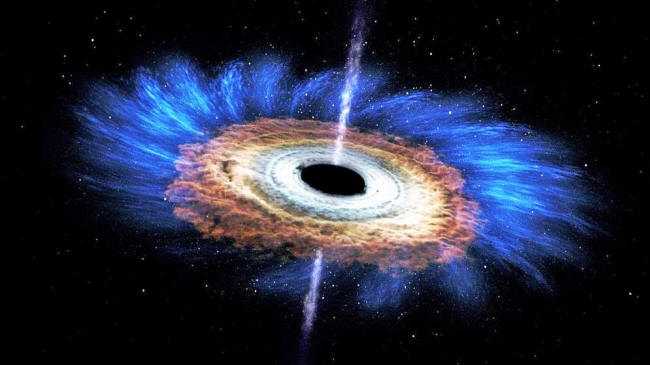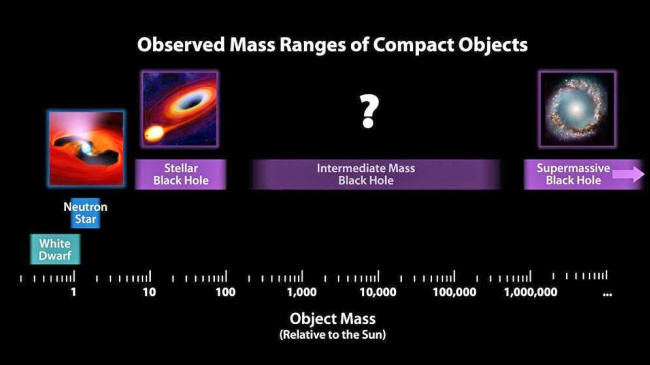|
from
PopSci Website about the mysterious life cycle of a Black Hole...
Instead of a cosmic
drinking straw, a black hole is a place in the universe that is so
massive and dense that anything caught in its significant
gravitational pull is unable to escape. Black holes have been in the news a lot lately, from the swarm found near the supermassive black hole at the center of our galaxy, to the fastest-growing black hole ever observed, which ingests the equivalent of the mass of our Sun every two days, to the most distant black hole ever detected, dating to the dawn of the universe.
From their inception to their potential demise far in the future, black holes are a fascinating part of our universe. Here's their story as we understand it now, from start to finish.
Birth
A stellar-mass black hole starts its life with a death.
It's born when a star at least 10 times more massive than our Sun runs out of fuel, having already fused hydrogen into helium, and helium into other elements, from carbon and oxygen all the way up to iron deep in the star's core.
With a weighty metal heart it has nothing left to bind together. It's reached the end of its lifespan, and it explodes, sending the outer layers out in a violent burst as the core collapses in on itself.
This link between the birth of a black hole and the death of the star that formed it is a fairly common occurrence across the Universe.
Stars and black holes are closely intertwined, especially in areas of the universe where star formation is churning along at high speed.
In what Bentz calls a 'giant recycling program,' the creation of black holes can actually spark the formation of new stars as well.
When a group of new stars form, the most massive among them die out very quickly, exploding at the end of their short lives.
But stellar-mass black holes are only a small part of the picture. Much weirder are supermassive black holes, giant beasts whose origins are far more obscure.
They've been observed at the center of galaxies, including our own, and seem to have a slightly different way of forming than their smaller compatriots.
Astronomers know that supermassive black holes got really big, very fast, showing up around 13 billion years ago.
At that point, Jillian Bellovary says,
The other option is that maybe supermassive black holes got their start in early galaxies, as smaller black holes formed and coalesced in the center of infant galaxies.
The precursors to these early supermassive black holes were likely moderately sized to start with, says Bellovary, and would have had to be larger than a mere stellar mass black hole, which wouldn't have been able to grow fast enough in such a short period of time to form the behemoths of the early universe that we've observed.
Researchers are still trying to figure out how those first black holes would have formed from the hot gas and dust of the early universe.
Typically, when matter like that collapses together, it forms stars.
So there may have been something different about the chemistry of the early universe that helped kindle those initial black holes.
The chemistry of the early universe, as well as the motion or lack of motion of the gas, could have helped trigger black hole formation in those early eons.
Growing up
Black holes don't just stay at the same size forever.
They get their undeserved reputation because things that fall into them can never get out, and are instead added to the collective mass of the black hole, letting it grow.
Acquiring gas might be the most efficient way to grow, but black holes don't shy away from mergers.
Collisions between black holes end with the two invisible masses uniting, something that scientists can observe with the Advanced Laser Interferometer Gravitational-Wave Observatory, or LIGO, which first detected gravitational waves from the merger of two black holes in 2015 (the announcement of the discovery came in 2016).
There's a huge size gap between supermassive and stellar mass black holes, where by all accounts there should be intermediate black holes-medium-sized, Goldilocks-approved black holes that fit just right in between their smaller and larger cousins.
The only problem is that researchers haven't observed them yet.
Where are all the
intermediate black holes hiding?
That doesn't mean that intermediate black holes don't exist, and many researchers are actively looking for them.
But they are hard to detect with visible light, unlike nearby stellar-mass black holes, which astronomers can observe ripping apart stars, or supermassive black holes, which acquire so much gas and dust and mass that the colliding particles falling in shine brighter than anything else we've seen in the Universe.
They also are expected to shine more in x-ray wavelengths of light, and there are already other objects in the Universe that dominate that particular spectrum.
Death
Whatever the size, black holes go through certain phases - coming into being, growing - throughout the course of their existence.
But can they ever die? Stephen Hawking thought that it might be possible, through a physics mechanism that is now known as Hawking radiation.
The idea is that if a black hole were sitting there by itself (no longer accreting mass) it could eventually be worn down by subatomic particles.
Bentz explains that it goes something like this:
If that process keeps happening repeatedly without more mass joining the black hole, eventually you can radiate the whole thing away.
But for black holes - whether stellar mass or supermassive or anything in between - it would take huge amounts of time to even make a dent.
The incredible amount of time and the huge difference in scale between a massive or supermassive black holes and subatomic particles means that the slow leak of Hawking radiation from a black hole is impossible to observe directly.
Experiments in laboratories on black hole analogs indicate that Stephen Hawking's theory was probably right, but there's still a lot we don't know about the potential end of a black hole's existence.
Unanswered questions
In fact, there's still plenty we don't know about black holes in general, but researchers like Bentz and Bellovary are working to fill in those gaping voids in our understanding.
Bentz is looking into just how massive the supermassive black holes at the center of distant galaxies can get. She's also researching correlations between the size of black holes and the properties of the galaxies that they live in.
She hopes that her observations could help inform computer models that help people figure out how black holes develop over time, and answer questions about the formation of the universe.
Bellovary is working on the Laser Interferometer Space Antenna, or LISA, a mission planned for the 2030s which will feature three spacecraft situated a gargantuan 2.5 million kilometers apart following behind Earth's orbit.
It will be a space-based gravitational wave detector - like LIGO, but focused on supermassive black hole mergers instead of stellar mass black hole mergers.
Black holes are intriguing, huge, and still very unknown, but there's one thing that researchers are certain of.
Bentz emphatically agrees.
When facing down people's fears that black holes are running around the galaxy devouring worlds and star systems, she likes to point out that if you replaced our Sun with a black hole of the exact same mass, not much would happen to Earth's orbit.
|



